Effect of Urban Revitalization on Promoting of Sense of Place (Case Study: Behrouzieh Alley & Heidarieh Religious Theater of Tabriz City)
Sevda Jabbari1 and Saghar Hosseinalizadeh1 *
1
Department of Urban Planning,
Islamic Azad University,
Tabriz Branch,
Tabriz
Iran
DOI: http://dx.doi.org/10.12944/CWE.11.2.13
The word "urban revitalization " has changed significantly especially since 1980s. Looking to future, urban revitalization indicates to "return to home" where "home" refers to human mind and its perception from the environment and sensory experience arising from being in urban spaces. The sense is not tangible and it is empowered through human recognition and its induction by memorial elements. Thus, citizens may participate and take actions in urban revitalization since it leads to urban revive in the modern world and provides a real city for citizens. Unfortunately, the concept of "sense of place" is weakened due to lack of appropriate and accurate revitalization interventions in historical contexts. According to the present article, this study aims at emphasizing on valuable elements to promote sense of place, appropriate revitalization interventions to empower sense of collective memory, highlight valuable elements and solve current problems found in quarters using revitalization approaches as well as appropriate practical and scientific strategies. Conceptual pattern of the article is based on analytical-descriptive method carried out through collecting informative and theoretical data from authentic scientific databases, studying specialized texts, using field studies, and noting the observations. According to the observations, this study focused on parameters of urban revitalization and sense of place including security, vitality, collective memory, Permeability, Compatibility, and building density. Using SPSS software, it was finally made clear that there is a direct relation between urban revitalization and sense of place.
Copy the following to cite this article:
Jabbari S, Hosseinalizadeh S. Effect of Urban Revitalization on Promoting of Sense of Place (Case Study: Behrouzieh Alley & Heidarieh Religious Theater of Tabriz City). Curr World Environ 2016;11(2) DOI:http://dx.doi.org/10.12944/CWE.11.2.13
Copy the following to cite this URL:
Jabbari S, Hosseinalizadeh S. Effect of Urban Revitalization on Promoting of Sense of Place (Case Study: Behrouzieh Alley & Heidarieh Religious Theater of Tabriz City). Curr World Environ 2016;11(2). Available from: http://www.cwejournal.org/?p=15379
Download article (pdf)
Citation Manager
Publish History
Select type of program for download
| Endnote EndNote format (Mac & Win) | |
| Reference Manager Ris format (Win only) | |
| Procite Ris format (Win only) | |
| Medlars Format | |
| RefWorks Format RefWorks format (Mac & Win) | |
| BibTex Format BibTex format (Mac & Win) |
Article Publishing History
| Received: | 2016-05-09 |
|---|---|
| Accepted: | 2016-07-19 |
Introduction
Relying on their historical specifications and traditional buildings, cities are regarded as the most valuable works of the past and inheritance of all cities and countries. Referring to historical background of these spaces, it is found that they include unique specifications. Accordingly, the urban planners and architects may make urban spaces important and meaningful through injecting modern thoughts to these contexts. This thought is regarded a kind of "intervention" in historical context arising from perception of human of urban spaces and remembering details of the space due to being attended there. Therefore, intervention methods in valuable contexts are defined as "urban revitalization ". The more accurate and harmonious revitalization measures along with cultural and historical values of a nation, the more stable and detailed the automatic memories are created in collective mind of city. On another hand, the spaces carry messages stimulating mind, emotions, and feelings of human. Therefore, perception and judgment toward a special environment is called "sense of place", i.e. mental perception of people of the environment and their conscious emotions from the environment. It creates an internal relation between human and environment such that perception and emotion of human are linked to and integrated with semantic context of the environment. The above definition is used to emphasize on importance of sense of place and its role in urban spaces. Also, there is a direct relation between this sense and intervention methods to improve quality of urban spaces. Ignoring the issue at small scales led to several problems and these problems resulted in carrying out the present study. The understudy area is a historical site containing social, historical, and cultural values. However, the concept of sense of place is faded there due to carelessness of the authorities and residents and passing of time. The mentioned values are considered less and they require revitalization interventions. Importance of the subject is felt considering unfamiliarity of the future generation with culture and identity of the past and its historical buildings and it will significantly affect human perception of the environment. Referring to historical documents of the recent decades, it is concluded that sense of place is destroyed in these regions due to lack of appropriate revitalization interventions and lack of sufficient knowledge of the site. According to the available data and field observations, prominent historical buildings are revitalized architecturally. However, the interventions are not sufficient and require urban revitalization measures. If the issue is not dealt with sufficiently, the relation of human with place and quality of perception of the environment will reduce, the outcomes will last to future, and the next generations will suffer from identity crisis. Therefore, the present study aims at evaluating effect of urban revitalization on promoting sense of place emphasizing on qualities of urban design in Behrouzieh Alley and Heidarieh Religious Theater of Tabriz which encompasses Sorkhei House, Sharbat Oghli House (Iranology Foundation), and Bazarcheh Sorkhab- a symbol of famous small markets of Tabriz. This research emphasizes on importance of role of sense of place parameters and relation of these parameters with urban revitalization.
Importance and Necessity of Research
Necessity of this study comes back to strengthen collective memory of main factors forming sense of place and inject revitalization intervention methods to valuable historical contexts to make the urban space harmonized. The relation between internal sense and perception of the environment indicates to importance of effect of urban revitalization on promoting sense of place.
In Iran, most historical contexts are inappropriately revitalized due to ignoring "sense of place". Innovating of useful methods may affect urban spaces and population. Induction of sense of confusion in people and residents is defined as the most important deficiency of all historical contexts. Therefore, the renovators should pay more attention to this process. At present, the problems may be reduced as far as possible using a reasonable budget. Thus, the related organizations may upswing "business" through accurate investment and allocation of reasonable budget. In turn, it will lead to increase of "price of land" and transfer of inconsistent applications (shoe workshops, repair shops, etc.) to other parts of city. According to evidences and interviews with resident, this issue was seriously followed up because of some problems found in the quarter. Ignoring the problem will result in serious crisis in a near future.
Background of Research
Studying authentic scientific articles and global samples concerning urban revitalization measures which are consistent with current conditions and capabilities of the quarter, some approaches are selected and studied using following articles (table 1).1-3
Table 1: Scientific articles and global samples concerning urban revitalization measures
|
Author’s name |
Article’s Title |
Approaches |
conclusion |
|
Nil Uzun1
|
Effect of revitalization and construction of urban contexts: Three cases in Turkey |
- Structuralism approach of Marxist leaded by Smith (1979) - Person-centered humanistic approach of Lee (1996) |
- Automatic construction process in Jahangir quarter and consistency of this theory with Smith's differential theory of land - Consistency of construction process at Kozgonjouk quarter based on Lee's humanistic theory and postponement of differential theory of land through government's intervention - Use of DVP to plan residential areas, non-solving of transformation problem, and its transfer to other areas |
|
Mahshid Ghorbanian2 |
revitalization of central part of cities: Intervention pattern and revitalization instructions in perceivable sub-areas (2010) |
- Structural approach - Strategic approach |
- Use of potentials to solve the problems while referring to central parts of city, role of people, and participation of citizens - Facilitating revitalization process while referring to role of government and governmental policies and participation of private sectors in revitalization of central parts of cities and local organizations and their role in revitalization process |
|
Bahraini 3 |
Approaches and policies of urban revitalization (from revitalization to recreation of a sustainable city) (2014) |
- Integrated approach - Social sustainability approach |
- Recreation of sustainable city using the integrated approach while referring to participation of public and private sectors and role of people and local communities - Recreation principles of sustainable city emphasizing on local identity and sense of place - Forming competitive cities through maintaining local attractiveness and differences to inclusive vital places using landscape, recreation objects and strategies emphasizing on social sustainability approach |
Introducing Behrouzieh Alley & Heidarieh Religious Theater of Tabriz (figure 1).
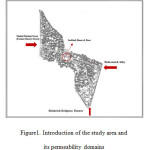 |
|
Heidar Tekyasi
At the beginning of Shahid Seghatoleslam Street, its west wing, opposite to Ghari Bridge, there is a famous place known as Heidar Tekyasi which has been used as business center of carpets woven in villages around Heris and carpet-weaving materials. This religious theater has interesting historical background and according to Hafez Hossein Karbalaei, "it is grave and tomb of Soltan Mir Heidar Toni, leader of Heidarians, located at A'ala Door (Baghmisheh Door). It is a famous religious theater from Ghalandarian Dynasty entitled to Malatya, born in Bakou of Shervan, honored because of charisma, and travelled a lot. In each city, he built a religious theater and settled one of his dervishes there. There is not any famous person among Ghalandarian Dynasty as he was. At the era of Gharayousef and his son, Mirza Eskandar, he lived in a religious theater built here (his grave). At that time, he was called Baba (Heidar) and Mirza Eskandar was really believed in him". At the end of Qajar era, part of this place and north of Ghari Bridge became center of immortality of the city but it was improved later. There is a famous proverb among Tabriz residents that "no respectful people go to Heidar Religious Theater".4
Sorkhab Quarter and Sorkhab Bazaar
Sorkhab quarter is an important quarter located at north of Tabriz and is surrounded by Eynali mountain (from north), Shotorban gate (from west), Mehranroud (Aji Chai) and part of Sheshgelan quarter (from south), and Sheshgelan and Seilab (from east). (Sajjadi ((Tabriz Sorkhab District & Alshra tomb)), 62) This quarter's name is derived from Sorkhab Mountain and Sorkhab Bazaar is located at south of Sorkhab historical quarter.
Being adjacent to Sorkhab Door (one of the historical gates of Tabriz) as well as its relation with city and main bazar, the Bazzar was very important in the past. Sorkhab Bazzar has access to Seyedhamzeh Tomb through Salili Passage (current Behrouzieh) from east and to Sahebolamr Tomb through Sarkaratiha and Ehtesham Passages from west. Following 1st and 2nd wars of Iran and Russia during Qajar era, the quarter became more important such that local association of Sorkhab was organized in 1974. However, it lost its civil life within the next years and became a small market far from events of the main Bazar.
Present and past functions of Sorkhab Bazar
Constructing of Daraei Street between main bazar and Sorkhab Bazzar, passing away of veteran carpenters who were old businessman of Bazaar and being employed in occupations other than carpentry by their offspring, resulted in changing of main function of Bazaar. On another hand, caravanserais found around Bazaar changed their functions to house, shop, workshop, and warehouses due to presence of vehicles. All mentioned factors significantly affected propagation and life of Sorkhab Bazaar. Although it continues its activity, its activities system has changed substantially. Following economic stagnation of Bazaar, rent of its shops was decreased (comparing with that of the main bazar) and a group of shoemakers started their occupation there. Some shoemakers took concurrent position at this place since they are intended to work in group. At present, carpenters' bazar has mainly changed to shoemakers' one. Among the shops producing and repairing shoes, there are some shops with other applications even carpentry. But, dynamism and vitality of Sorkhab Bazzar were replaced by settlement and made it less important.
Revitalization Measures of Sorkhab Door
Due to non-significance of Sorkhab Door and weariness of Bazaar context through time, the revitalization measures were directed by Region 10 Municipality and consulted by Civil-Technical Deputyship under title of "Restoration of Sorkhab Door" in 2013.
Sorkhei House
This house built in two stories during the second half of Qajar reign belongs to Mirza Mahdi Farashbashi, son-in-law of Mozaffareddin Shah. Sorkhei House has inner and outer parts. At north wing of the building, there is Mirza Mahdi's bathroom which was later severed and transferred. The house was recorded under No.2779 in Iranian National Monuments List in 2000 by Cultural Heritage Organization. According to Cultural Heritage, Handicrafts, and Tourism Organization of East Azarbaijan Province, there are about 800 houses at different parts of Tabriz especially those surrounded by the old eight gates which should be maintained and restored within 30 coming years. (IRNA, 2013)
Methodology
The present study was conducted through evaluating authentic documents and specialized texts concerning urban revitalization emphasizing on promoting sense of place. Additionally, library-field study method was also used to collect required data. Therefore, the present study was conducted in analytical-descriptive method and the required data was collected through interview with the statistical population (n=10) and 69 questionnaires were answered by the citizens.
Studying Effective Parameters Concerning Sense of Place and Urban Revitalization
From phenomenologists' viewpoint, sense of place means being linked to the place through understanding of symbols and routine activities.5 The sense may be created in living place of the person and develop through time. Sense of place is a complex combination of symbols, parameters, and qualities perceived by the person or group from a special space or region, consciously or unconsciously. If the parameters of sense of place are ignored, urban contexts and spaces will be meaningless. Thus, the inventors should pay attention to sense of place to effectively improve status of the damaged contexts. On another hand, urban revitalization means conscious intervention in urban spaces to prevent from their weariness and contemporize them. According to this definition, every urban space has its own unique specifications which should be taken into account by the renovators during design or intervention process. Before taking measure to revitalize a place, the renovators should imagine a final design and realize it relying on standard parameters and criteria. Following table refers to some definitions of parameters by the experts.
Table: 2
|
Parameters |
Experts |
Expert’s Viewpoint |
|
Security |
Golkar 6 |
Security is one of the most important factors making desirable quality in urban design. Security is so important in human life that John Lang, the famous American theoretician, refers to it along with physiologic needs of human, e.g. food, shelter, and health. |
|
Brownlow7
|
From a realistic perspective, the researchers defined security as a political and disciplinary term and, generally, define it as "protecting from values and confronting with risks and enemies". |
|
|
Security |
Jane Jacobs8
|
Explaining urban security to interaction of physical space, social processes making the environment are considered and emphasized on active space as a factor making the environment more secure and successful. |
|
Vitality |
Lenard 9
|
To have a revived city and vitality in urban environment, the places and conditions should be provided to create nice experiences. |
|
Golkar 10 |
Urban vitality is a perceptive-cognitive phenomenon formed in the process of exchanging physical and perceivable specifications of city, on one hand, and cultural patterns and codes, mental capabilities, previous experiences, and regulatory objectives, on another hand. |
|
|
Kevin Lynch 11 |
Vitality indicates to the extent where city form supports vital functions and biological needs and how it provides survival of all entities. |
|
|
Collective Memories |
Maurice Halbwacks 12 |
Halbwachs also calls individual memory “personal” and “autobiographical” memory and collective memory “social” and “historical” memory (1980:50–52). Autobiographical memory is the memory of things that one has experienced oneself, things that one can remember being present for. |
|
Rossi 13 |
One can say that the city itself is the collective memory of its people, and like memory it is associated with objects and places. The city is the locus of the collective memory. This relationship between the locus and the citizenry then becomes the city’s predominant image, both of architecture and of landscape, and as certain artifacts become part of its memory, new ones emerge. In this entirely positive sense great ideas flow through the history of the city and give shape to it (Rossi, 1982, p. 130) |
|
|
Compatibility |
Pourmohammadi 14 |
To determine the compatibility and incompatibility between two land use, specification and the different needs of each have to be determined to do normal activities and then compare this information to identify areas of agreement and disagreement |
|
Municipal council of California 15
|
Checking land use’s comparability is because of creating new land use and making positive communication with their neighborhoods in developed regions. This means to examination of the compatibility between land uses and to ensure that the development of the city for Each new user, a good neighbor to other neighbors will be done. |
|
|
Kapel D.E & Newka 16 |
Compatibility is a two-way process, from one person to communicate effectively with the community and on the other hand sees the community with the tools to prepare for his a person through the potential of the fact forgives. The interaction between the individual and society has undergone a transformation and reconciliation to occur relatively stable. |
|
|
Permeability |
Bentley et al 17 |
The permeability of any system of public space depends on the number of alternative routes it offers from one point to another, we call such quality a physical permeability. (Physical permeability) But Those alternatives must be visible, otherwise only people who know the area can take advantage of them. (visual permeability) Smaller blocks can help to increase visual permeability (by improving people awareness of the choices available) but it should be accompanied with another factor which is the shape of blocks itself: The Simpler the orthogonal shapes of blocks the easier it is to see from one junction to the next in all directions. |
|
Stamps 18 |
Impressions of enclosure were much more influenced by visual permeability than by locomotive permeability, but the reverse was found for impressions of safety, which were more strongly influenced by locomotive than by visual permeability. (Stamps, 2005, p. 37:587-619) |
|
|
Perkins, D. meeks, J. and taylore 19 |
Studying 48 blocks in three working-class urban neighborhoods in New York City found that wider street tended to invite more traffic and make blocks more “permeable” to crime. |
|
|
Building Density
|
De Chiara et al 20 |
The building density or FAR is the ratio of surface infrastructure. |
|
Kono Tatsuhito 21 |
Building density over the entire surface area of the building include the piece of land that the building is located. The provisions of building density, population density to reduce the negative side effects that limit the right size to control the number of households with buildings. |
Distribution of Comments of Repliers about Security Quality of Sense of Place
Studying the statistical data indicates to abnormal distribution of security quality in the quarter considering comments of people, i.e. there were five items in the security questionnaire with minimum and maximum points of 10 and 21, respectively. It indicates that security quality has a little dispersion. Accordingly, some people feel secure while others do not. Considering skewness (-0.197), average security quality equals the minimum value of (16–15.88).
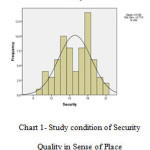 |
|
Distribution of Comments of Repliers about Vitality Quality of Sense of Place
Studying the statistical data indicates to abnormal distribution of vitality quality of the sense of place in the quarter considering comments of people, i.e. there were three items in the questionnaire with minimum and maximum points of 4 and 15, respectively. It indicates that vitality quality of sense of place has very little dispersion. Considering skewness (-0.095), average vitality quality equals (10 – 9.99).
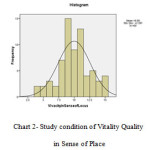 |
|
Distribution of Comments of Repliers about Compatibility Quality of Urban Revitalization
Studying the statistical data indicates to abnormal distribution of compatibility quality of the quarter considering comments of people, i.e. there were two items in the questionnaire with minimum and maximum points of 9 and 20, respectively. It indicates that consistency quality has a little dispersion. Accordingly, some people are satisfied with consistency quality while others do not. Considering skewness (0.211), average consistency quality equals (14 -14.03).
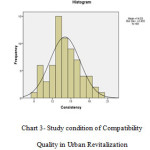 |
|
Distribution of Comments of Repliers about Vitality Quality of Urban Revitalization
Studying the statistical data indicates to abnormal distribution of vitality quality of urban revitalization in the quarter considering comments of people, i.e. there were two items in the questionnaire with minimum and maximum points of 2 and 10, respectively. It indicates that vitality quality of urban revitalization has a little dispersion. Considering skewness (-0.326), average vitality quality of urban revitalization equals (8 – 7.36).
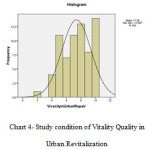 |
|
Studying Memorable Parameter of Sense of Place
According to the results, memorable is a qualitative parameter. Therefore, results of the questionnaires emphasize on evaluating of memorable parameter in the urban context considering prominent elements and memorials. Generally, it indicates to the most important memorable parameter found in context of Sharbatoghli House (36 out of 69 repliers) and Bazarcheh Sorkhab (20 out of 69 repliers). Also, feeling of the people when entering this place was studied and tranquility (20 persons out of all), affiliation (17 persons out of all), and insecurity (15 persons out of all) were introduced as the most significant feelings.
Results
Results of Explanatory Findings: Data Analysis
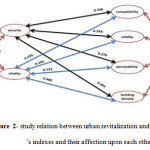 |
|
According to the results, four parameters of urban revitalization, i.e. compatibility, permeability, vitality, and building density and three parameters of sense of place, i.e. security, vitality, and collective memory were studied as appropriate factors and required parameters of the context. The memorable parameter of sense of place is a qualitative parameter and is studied separately. To evaluate the relation between parameters of urban renovation and sense of place, two parameters of permeability and security, as quantitative factors, were studied. Following table refers to relation of these two parameters in detail. The correlation coefficient of these parameters is 0.021 which is always positive and correlation intensity is 0.276. The correlation intensity of -1 indicates to indirect relation found between permeability and security. Since it is positive, however, there is a direct relation between them. According to statistical principles, correlation intensity will not exceed 1. The correlation intensity of permeability is one. Therefore, the more close to 1, the more direct the relation and the more close to -1, the more indirect the relation. On another hand, error and confidence percent is 5% and 95% for permeability-security variables and 1% and 99% for other ones. The following table describes the correlation coefficient and intensity of the variables quantitatively.
Conclusion
Considering what described about effect of urban revitalaziation on promoting sense of place, parameters of urban planning are used to prove the relation found between them. The present research studied seven parameters of urban planning considering context of Bahrouzieh Alley and Heidar Religious Theater and it was tried to find a relation between urban revitalaziation and sense of place. In this study, there was a strong relation between permeability and vitality of sense of place as well as between Compatibility and vitality of sense of place. The weakest correlation intensity was found between Permeability and security, between Compatibility and security, and vitality of urban revitalaziation and vitality of sense of place. Therefore, vitality quality is a common parameter between urban revitalaziation and sense of place and it should be considered in revitalaziation measures and its effect on sense of place may not be ignored. Additionally, there is an important relation between security and Permeability and Compatibility in the quarter. Less intensive correlations indicates to weakness of the understudy context. To promote sense of place in the context, these three relations (with the least correlation intensity) should be considered such that sense of place is deeply perceived by the residents. It indicates to improvement of quality of urban space.
Acknowledgement
We are deeply grateful to many for their support for our paper: In the end, that’s our duty to appreciate our honorable professor Dr. Masoud Haghlesan because of his efforts and guidance in completion of this essay. This work would not have been possible without his guidance. Thank you for your commitment, dedication, criticism and encouragement. Thank you to our parents, who have supported us permanently and stand by our sides in dilemmas in order to pass this way with special courage.
References
- Tehran Renovation Organization -00905, Author: Nil Uzun. Translators: Zoaghi, Ali, “The impact of modernization and renovation of Urban Fabric: Three case study in Turkey”, Renovation publication, second years, Number 9.(2010)
- Ghorbanian, M., Reconstruction of the central part of the city: a model of intervention and an restoration recipes are in the areas of understanding. Scientific- research publication of Iran Architectural and Urban scientific community, 1: 77-90. (2010)
- Bahraini, S.H. & Izadi Saeed & Mofidi Mehranoush, Approaches or policies of urban renewal (from reconstruction to sustainable urban regeneration, Urban studies scientific and Research Quarterly, 9: 17-20. (2014)
- Khamachi. B..Cultural and historic neighborhoods and celebrities of District 8th of Tabriz”, Terhan press, Tehran. (2005)
- Relph, E.. “Place and placelessness”. London: Pion.(1976)
- Golkar, K., Creative components of quality in Urban Design, Soffeh scientific- research publication, Number 32, Tehran. (2000)
- Brownlow, Alec, “A geography of men_s fear, Department of Geography and Urban Studies”, Temple University, Philadelphia, PA 19122, Geoforum 36, (2005)
- Jacobs J, “Death and life of great American cities”, Parsi, H and Aflatooni A., Tehran university press, pp. 27-93, (2007)
- Lenard, C., Souzanm H., Urban space design and social life, Tehran, Architecture and Urbanism publication, Number 44 & 45, Tehran.
- Golkar, K., the concept of vitality in urban design, Tehran, Soffeh Scientific- Publication, Number 44. Tehran.
- Lynch, Kevin A.. The Theory of Good City Form, Translated by Bahraini, Seyyed Hossein, Tehran University.
- Halbwacks, Maurice, The collective memory, translated by Francis JD JV, Vid YP, reprinted by Harper Colophon books.
- Rossi, A., The Architecture of the city, Cambridge, the MIT press, Massachussetss, Page 130.
- Pourmohammadi, M., “Urban Land- use planning”, Tehran, Samt publisher, Fourth edition, (2008).
- Municipal, council of colifornia, “City of Palos verdes Estates Neighborhood compatibility Application” , (2008). Available online: http://www.pvestates.org/index.aspx?page=240
- Dejnozka, E. and Kapel, D.E.. American Educators’ Encyclopedia. Kapel, D.E., Gifford, C.S. and Kapel, M.B. (Eds.). New York: Greenwood Press. P. 151.
- Bentley, A., Murrain, McGlynn, S. Responsive environments a manual for designers”, Butterworth-Heinemann ltd., Linacre House, Jordan Hill, Oxford (1995)
- Stamps, A. E.. Visual permeability, locomotive permeability, safety and enclosure. Environment and Behavior, 37:587-619, (2005).
- Perkins, D. meeks, J. and Taylore , The physical environmental of street blocks and resident perceptions of crime and disorder. Journal of Environmental Physicalogy, 12, pp. 21-34.
- De Chiara, J. Panero, J. Zelenik, M.; “Time – saver standards for Housing and residential development”, (second edition) Mc GRAW-HIL, Inc. New York, San Francisco, Washington, D.C. Auckland, Bogotá, Caracas, Lisbon, London, Madrid, Mexico City, Milan, Montreal, New Delhi, San Juan, Singapore, Sydney, Tokyo, Toronto, (1995).
- Kono, T., T. Kaneko, H. Morisugi. Necessity of minimum floor area ratio regulation: A second-best policy, The Annals of Regional Science, 44: 523-539.
- Assari A., TM. Mahesh, E.Assari.”Conservation of Historic Urban Core in Traditional Islamic Culture: Case Study of Isfahan City.” Indian Journal of Science and Technology, Vol.5, No.1, pp.1970-1976, January (2012).
- Assari A., TM. Mahesh. “Demographic Comparative in Heritage Texture of Isfahan City.” Journal of Geography and Regional Planning, Vol.4, No. 8, pp.463-70, June (2011).
- Assari A., TM. Mahesh, E.Assari. “Role of Public Participation in Sustainability of Historical City: Usage of Topsis Method.” Indian Journal of Science and Technology, Vol. 5, No. 3, pp. 2289-94, March (2012) .
- Assari, TM. Mahesh, MR. Emtehani, E .Assari. “Comparative Sustainability of Bazaar in Iranian Traditional Cities: Case Studies in Isfahan and Tabriz” International Journal on Technical and Physical Problems of Engineering (IJTPE), Issue 9,Vol.3, No.4, pp18-24, December (2011).
- A. Assari, E. Assari. “Urban Spirit and Heritage Conservation Problems: Case Study Isfahan City in Iran.” Journal of American Science, Vol.8, No.1, pp.202-109, (2012).






